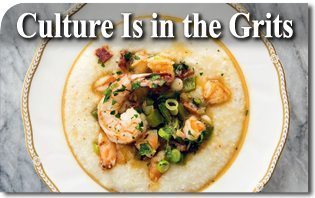
Your college experience may be characterized by the desire to look beyond your origins and explore the world with grand adventures. There is certainly nothing wrong in venturing out and embracing what the world has to offer. There is a temptation to be avoided, however: to think you acquire “culture” or sophistication by simply experiencing a vast array of choices that includes exotic places, natural foods, and the latest fads.
“Modern culture is defined by this extraordinary freedom to ransack the world storehouse and to engorge any and every style it comes upon,” writes Daniel Bell in his book The Cultural Contradictions of Capitalism. This notion of culture is defined by the individual’s claimed right to experience everything in the name of self-fulfillment. It is a quest Bell describes thus: “nothing is forbidden, all is to be explored.”
Yet this eclectic notion of culture is incredibly superficial and individualistic, cold and artificial. It fails to make those rich connections within a society, its shared attitudes, values, products, and practices. Like so many words in our society today, culture becomes whatever the individual wants it to be.
There are those who think culture is about surrounding yourself with certified “organic” foods, craft beers, and free-range chickens. While such things do have organic aspects, there is something terribly unorganic, uncultural (and expensive) about this perspective.
That is because the proper use of the term organic presupposes a society. Inorganic things are mechanical, mass-produced, and indifferent to place. Truly organic things spring from life and come from the natural interaction of people, places, and things. They have soul and meaning.
Learn All About the Prophecies of Our Lady of Good Success About Our Times
In an organic culture, the best things in life are simple and accessible. People take basic elements and raise them to amazing degrees of perfection. The result is an extremely rich, even sublime expression of a people.

A good example of this is grits. You can’t get more basic than grits. Nothing could be simpler than this southern staple of ground corn boiled in salted water and milk. However, nothing can be further from the real thing than the industrialized add-water-milk-and-quick-stir varieties that pass for grits at so many diners and homes.
Authentic grits require the human element to enter into their making. People then develop local versions that give soul to the ground-corn mixture.
Real organic grits are simple but they do take time. Some say they should simmer for hours at the lowest possible temperature to get all the corn flavor into the dish. Grits can be mixed with diced bacon, bell pepper, onion, or any other often local ingredients, allowing for an enormous variety of grit dishes. Charleston’s archetypal grits, for example, are served with freshly caught roe shrimp.
And that is the beauty of organic society. No two grits are alike. There is no one-grit-fits- all dish. The fundamental ingredients are all the same, but the embellishments are so refreshingly different and local.
That is why you cannot just buy “organic society” grits off a Whole Foods shelf. There must be that vital connection between the product and the consumer. True grits needs to be anchored in a place and loved by inhabitants.![]()
FREE e-Book: A Spanish Mystic in Quito
Indeed, there was a time when people could perceive where they were simply by the flavor of the local grits. Each small town or region in the South has its own variety of grit corn that came from seeds handed down over generations. “They all have a voice,” observes Charleston chef Shawn Brock in a Wall Street Journal interview. “Each one carries stories, each has its own personality, each is a history lesson.”
Such varieties of corn are generally not as commercially viable because they do not produce huge yields, but their incredible taste makes up for any shortcomings. Locals become sensitive to such tastes and naturally prefer them over others.
Not only does the variety of corn make a difference to grits but the actual soil where the corn is grown also influences the taste. Corn, like so many products, picks up the flavor of the land where it grows. Real grits connoisseurs can pick up the subtle difference between corn from bottom land and that from mountainside plots. Climate also enters into the equation, making grits part of southern culture, since grit corn does not do well in harsh northern climes.
The Quest for “The Unreachable Star” in Bourbon

When people, grits, and place organically come together, something amazing happens. By constantly adjusting available materials to local tastes, producer and consumer become the “co-creators” of these dishes. A local cuisine develops when chefs and those who cook constantly adjust local dishes and native ingredients to reflect what local people like. They experience the spiritual joy of tasting the product of their joint creativity with the materials at hand.
That is why true grits belong to everyone in the region, not just one social group. Excellent variations are served in fine restaurants, family homes, and rustic truck stops. Simple grits become a point of unity and a true expression of a people and place.
And when people share not only grits but all sorts of foods, fashions, and styles, a rich culture is born. Everything becomes a manifestation of the strong personality of those who inhabit a region. People come to understand that their region is made for them and they for their region, which offers them a wide variety of supreme delights no other place can offer.
“In a highly developed culture this sense of style permeates everything,” writes Richard Weaver. “It is in dress and manners, in art and institutions, in architecture and cookery. It imparts tone to the whole of society by keeping before its members the standard of the right and not right.”
That is the problem with much our modern “culture.” It really isn’t culture. Postmodern “culture” is about disconnected experiences that have no meaning, narrative, or context. There is no organic relationship between the cultural object, the people, and place. A dreary sameness has descended upon society. The globalized commercialization of everything tends to reduce real culture into “a handful of quaint old customs, maintained like bones in a museum.”
Thus “culture” comes to mean the top-down production of exotic (and expensive) foods and handcrafted products available globally. Some think it “cultural” to adopt modern architectural styles indifferent to the climate and place. Others seek to find “culture” in natural water from Iceland, tasty mushrooms from Transylvania, or any other such products that may be excellent in quality but that have nothing to do with the locality. The vital link has been severed.
There is nothing wrong with occasionally experiencing the culture of others. It is wrong to assume, however, that you must constantly look outward to acquire culture. You must above all look inward and to your origins. Whether it be a local clam chowder or gumbo, a cowboy boot, or a region’s distinctive musical tradition, everyone can claim to be the part of some culture. Culture is not found in some prepackaged experience. Sometimes it is found in the grits.
As published in the Intercollegiate Review.


